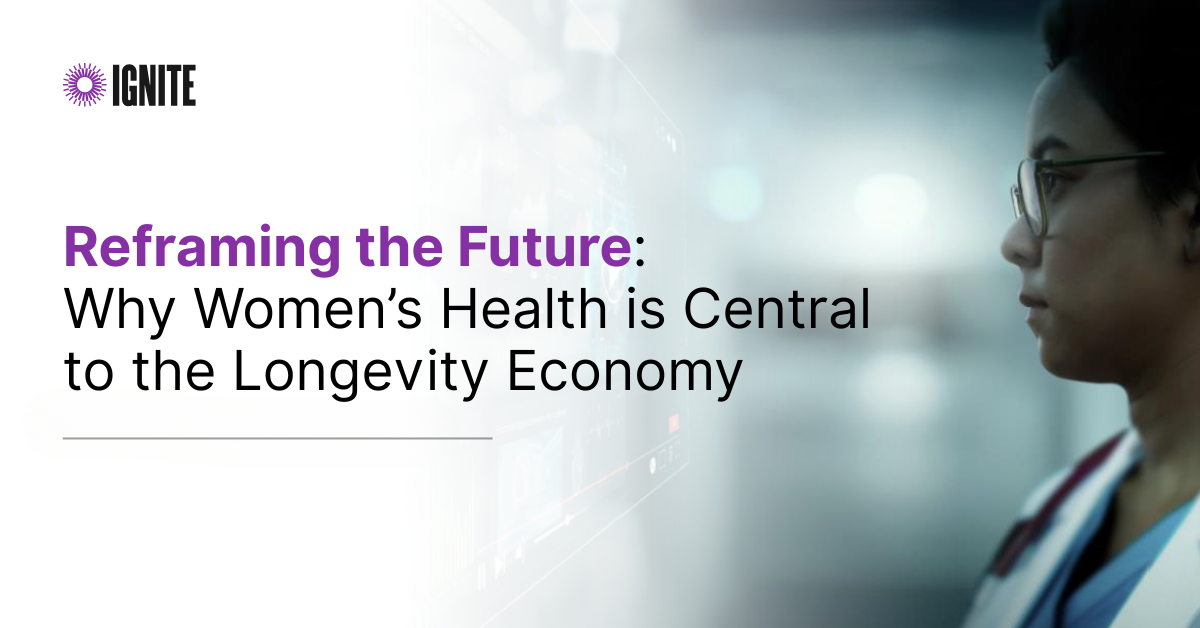
For decades, women’s health has been underfunded, under-researched, and narrowly defined. But at Ignite’s Shaping the Future of Healthcare Summit, a gathering of 67 industry leaders held this March, a clear and compelling message emerged: women’s health isn’t a niche. It’s the key to solving some of healthcare’s most complex and costly challenges.
Redefining the Narrative
Lori Frank, advisor and former President of Women’s Health Access Matters (WHAM), led a pivotal conversation, urging the industry to stop treating women’s health as a niche, and start recognizing its full clinical and economic potential.
WHAM’s evidence-based framework expands what qualifies as women’s health to include:
- Conditions unique to women (e.g., endometriosis, menopause)
- Conditions more prevalent in women (e.g., autoimmune diseases, Alzheimer’s)
- Conditions experienced differently by women (e.g., heart disease, depression)
This broader, more accurate lens opens up a significantly undercapitalized market, creating new opportunities for founders, funders, and healthcare organizations to innovate at scale.
A Longevity-Driven Market Opportunity
An equally important shift is reframing women’s health not as a subset but as a strategic pillar of the longevity economy. As healthcare systems and investors increasingly focus on prevention and healthspan, women’s health is moving to the center of the conversation.
Companies like Midi Health are leading the way. By offering “insurance-backed longevity care for women,” they’re repositioning hormone health, midlife wellness, and preventive care as fundamental to lifelong vitality and productivity. Speaking the language of longevity is unlocking access: to payers, employers, and capital.
Thought leaders like Dr. Peter Attia are reinforcing this shift. His podcast The Drive and bestselling book Outlive have spotlighted topics like perimenopause, hormone therapy, and sexual health into mainstream longevity discussions. His interview with Dr. Rachel Rubin reframed these issues not as optional, but essential.
Science, Systems, and Scale
This isn’t hype, it’s backed by research and infrastructure
- CU’s Ludeman Family Center for Women’s Health Research is leading the charge on sex and gender differences in cardiovascular, brain, and metabolic health, translating science into real-world applications.
- Harvard’s Wyss Institute is using organ-on-chip models to study female biology at the cellular level—filling major gaps in diagnostics and therapeutics.
- The Buck Institute for Research on Aging and the Global Consortium for Reproductive Longevity & Equality (GCRLE), co-founded by Dr. Jennifer Garrison, are targeting ovarian aging, linking it to chronic disease and overall healthspan.
- Women’s Health Innovation Coalition (WHIC) and the Global Council on Women’s Health are helping drive policy, partnerships, and funding pathways that reflect the full scope of women’s needs over the lifespan.
Market Signals Are Clear
- Midlife Tech & FemAging: The menopause market alone is projected to surpass $24B by 2030, with startups like Elektra Health, Vira Health, and Gameto offering personalized care targeting hormonal, cognitive, and metabolic health.
- Employer Benefits Expansion: Companies are rapidly adding menopause, metabolic, and mental health solutions for women 40+—via platforms like Maven Clinic, Carrot Fertility, and Peppy Health.
- Longevity VC and Personalized Platforms: Investors including Juvenescence, Longevitytech.fund, and LifeForce Capital are placing bets on personalized, preventive platforms built for women’s evolving health needs.
- Data-Driven Metabolic Optimization: Experts like Dr. Stacy Sims and Kara Collier (Nutrisense) are reframing the aging process for women using science-backed approaches to hormone health, nutrition, and performance tracking.
This is not just a market trend, it’s a correction. One that recognizes that investing in women’s health is not only equitable, it’s smart business.
What Comes Next
At Ignite, we don’t see this as a pivot, but a breakthrough. Changing how we define and talk about women’s health shapes who listens and who invests. It opens the door to data, diagnostics, and delivery models that are long overdue. And it reframes women’s health as a powerful lever in shaping the future of healthcare, one rooted in science, scale, and opportunity.
This is more than a movement. It’s a new market. And the women building it are just getting started.



